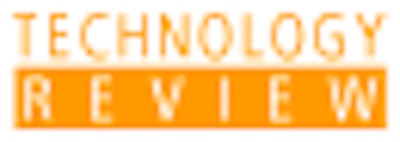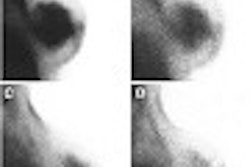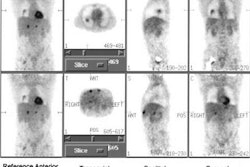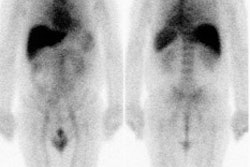
No imaging modality has taken a more circuitous route to clinical acceptance than PET. With its roots in research conducted half a century ago, PET was nearly written off for dead in the early 1990s. But increasing reimbursement and a growing number of clinical applications have sparked an almost insatiable demand for the metabolic data that PET alone provides.
Today, PET is demonstrating its utility in a wide range of pathologies, from cancer to neurodegenerative diseases. Procedure volume and scanner sales are surging as more and more imaging facilities embrace the modality. Even small community hospitals are offering PET imaging, not an insignificant step considering PET’s academic roots.
But while its utility has become a point of fact, many questions remain about the nuts and bolts of starting a PET service. There are new choices in crystal materials, for example, that provide additional capabilities beyond the old standby, bismuth germanate (BGO). New hybrid CT/PET scanners offer exquisite images that fuse metabolism with anatomic landmarks -- but at a price. In many ways, the hard part of the PET acquisition process comes after one has decided to take the plunge.
History
Positron emission tomography (PET) has been in clinical use since the early 1990s, while its history dates back to early research in the 1950s. Instruments developed in the 1960s and early 1970s were technically limited to brain imaging only. The first PET center was established in the mid-1970s at the University of Pennsylvania in Philadelphia.
PET differs from anatomic-based imaging modalities in that it assesses the level of metabolic activity and perfusion in various organ systems. The process produces biologic images based on the detection of gamma rays that are emitted by a radioactive substance such as fluorine-18 fluorodeoxyglucose (FDG).
FDG is produced in a cyclotron and is tagged to a natural body compound, commonly glucose. When FDG is administered intravenously to a patient, the radioisotope decays, producing gamma rays (photons). These gamma rays strike scintillation detectors composed of inorganic crystals such as sodium iodide (NaI), bismuth germanate (BGO), gadolinium orthosilicate (GSO), or lutetium oxyorthosilicate (LSO), allowing the source of each pair of photons to be identified with precision.
PET studies are usually conducted on dedicated PET cameras, but nuclear medicine vendors have developed upgrades for gamma cameras that enable them to be used to image FDG, in a process known as coincidence detection.
Dedicated PET refers to full-ring positron emission tomography cameras. Gamma cameras use the same underlying technology as PET, with the main differentiating features being a limited ring scope and usually lower image quality at higher energies.
One of the latest trends in PET instrumentation is the development of hybrid CT/PET scanners, which incorporate a complete CT system and PET camera in the same gantry. These systems produce fused images that demonstrate both metabolic processes and anatomic landmarks. The scanners have the potential to revolutionize medical imaging, but their high price tags will be a barrier for medical facilities.
Current and future clinical applications
PET provides quantitative in vivo measurement of functional processes such as perfusion, metabolism, and receptors. Its primary uses are in oncology, cardiology, and neurology, although monitoring infectious processes is also promising.
Specific applications include the following:
- Oncology. PET scans are used to detect cancer and to examine the effects of cancer therapy by showing biochemical changes within a tumor. PET is the study of choice in differentiating benign from malignant nodules, according to Dr. Abass Alavi and Dr. Martin Reivich of the University of Pennsylvania. The authors believe that although PET plays a diagnostic role, its major contribution has been in the accurate staging of cancer. FDG-PET is the imaging technique of choice for staging of Hodgkin’s and non-Hodgkin’s lymphoma, and for staging of lung cancer and other tumors.
- Cardiology. PET scans of the heart can determine blood flow to the myocardium and help evaluate coronary artery disease. PET can help differentiate nonfunctioning myocardium from myocardium that would benefit from angioplasty or coronary artery bypass surgery to re-establish adequate blood flow.
- Neurology. PET scans of the brain are used to evaluate patients who have memory disorders of undetermined etiology, brain tumors, or seizure disorders that are not responsive to therapy, and are therefore candidates for surgery. PET is also used in Alzheimer’s disease therapy to monitor outcomes with a variety of newer medications.
- Psychiatry. PET has shown that successful treatment of obsessive-compulsive disorder (OCD) with medication or with behavior therapy produces similar reductions in activity in the brain's basal ganglia. The findings also suggest that OCD involves a specific biological abnormality.
- Therapy. PET is increasingly important in planning and monitoring radionuclide therapy.
Procedure mix and volume
More than 40,000 PET procedures were performed in the U.S. between April 1 and June 30, 2001, an increase of 7% over the estimate of 37,400 procedures in the fourth quarter of 2000, according to a study released last October by IMV Medical Information Division of Des Plaines, IL.
From a revenue perspective, oncology leads the way in approved procedures and number of tests performed, while cardiology indications are promising because of the sheer number of people who have heart disease.
The experience of the Hackensack University Medical Center may be typical. The institution has performed more than 2,000 PET procedures since May 1999, according to Dr. Harry Agress Jr., director of the institution’s division of nuclear medicine. "About 95% of the procedures are oncology, while the rest is a mix between cardiology and neurology," Agress said.
The IMV study showed the start of a decline in PET procedures performed by coincidence detection SPECT cameras, most likely due to the decision by the Centers for Medicare and Medicaid Services to restrict reimbursement to dedicated PET scanners.
Reimbursement and ROI
Improving reimbursement is driving PET’s growth in the U.S. The boom first gained momentum in 1998, when the Health Care Financing Administration granted limited coverage for PET’s first oncology application, lung cancer. (Another PET tracer, rubidium 82, has been reimbursed since the mid-1990s as a cardiac perfusion imaging agent.)
The successor agency to HCFA, the Centers for Medicare and Medicaid Services, has expanded Medicare’s coverage of oncology procedures to include broadly differentiated cancers, as well as one or two neurological and cardiac studies using FDG.
But Medicare reimbursement for clinical PET didn't come without a hitch. Medicare’s original reimbursement level for the first oncology procedures it covered was $2,331.18, a healthy payment level. But the agency decided to reduce that amount, and PET is now reimbursed at a far lower rate of $1,850 ($1,375 for the procedure and $475 for the FDG).
It doesn't look as though Medicare will pay for PET scans of Alzheimer’s patients anytime soon. A CMS panel recently affirmed a lower panel’s rejection of PET coverage for the diagnosis and management of Alzheimer’s disease.
But industry observers are optimistic that CMS will approve payment for additional new applications, according to PET center consultant Jennifer Keppler of KE Solutions in Silverado, CA. A number of new uses are already on the agency’s plate.
"They recently cleared an expansion of a cardiac indication for myocardial viability, and for breast cancer," she said. Both will take effect in October 2003. "Also on their agenda is the use of FDG-PET in thyroid cancer and in soft-tissue sarcomas."
Keppler said a PET advocacy group, the Academy of Molecular Imaging, is submitting another petition for what are called "orphan cancers," tumors such as testicular cancer that occur less frequently, and thus make it difficult to be researched with large studies.
Agress is also optimistic that CMS will clear additional new PET applications. He believes that most oncological applications are headed for coverage.
"Things that I think will be approved in the future would be thyroid and various sarcomas," Agress said. "Breast (cancer coverage) has changed already, so that’s going in the right direction. (Other applications include) pelvic malignances, cervical and ovarian carcinomas, soft-tissue sarcomas, pancreatic (tumors), and, potentially, detection of unknown primary tumors."
PET is becoming so popular that even smaller community hospitals are looking into either having a PET center or contracting with a mobile PET provider. But with even entry-level PET cameras costing over a million apiece, sites need to do their homework before making the leap into PET.
There are several factors that determine whether a PET center will become profitable -- one is procedure volume. Most sites need three to four procedures a day to break even, according to Keppler.
"It depends on the cost of the equipment and how you set up your infrastructure," said Keppler, who along with Dr. Peter Conti of UCLA has authored a PET cost analysis study (American Journal of Roentgenology, July 2001, Vol. 177:1, pp.31-40).
Navigating the complex reimbursement scene is also crucial in PET, given its ever-changing landscape, she said.
Medicare reimburses by means of G-codes, a kind of temporary CPT (current procedural terminology) code used to bill specific PET procedures. There are more than 20 such codes for FDG oncology imaging, for instance, one each for FDG brain and myocardium, and 18 G-codes for myocardial perfusion imaging with rubidium-82.
CPT codes are less specific than G-codes. For instance, brain imaging for metabolic evaluation is 78608, for perfusion evaluation 78609. Myocardial imaging (metabolic) is 78459, while a single myocardial perfusion study at rest or stress, or multiple studies at rest or stress, is 78492. Tumor imaging (metabolic) is 78810. A diagnostic radionuclide is CPT 78990, while an FDG injection is S8085.

Click here to view a PDF chart of reimbursable PET procedures, compiled from CMS sources by Jennifer Keppler of KE Solutions, Silverado, CA.
"The most important thing I’ve seen in profitable sites around the country is really having dedicated people working on reimbursement at the facility, because of the large number of G-codes for billing and the documentation requirements," Keppler said.
Keppler said a staff member must make sure documentation is kept on file at the PET facility, and, if need be, sent to Medicare to justify payment for the procedure.
"Rather than actual billing expertise, it’s somebody who understands billing and understands what’s going on with these patients so they can make sure the data are pulled together," she said. "(That person) manages the reimbursement process to follow up on claims."
Features and benefits
So, you’ve decided that you can produce the referrals and generate the reimbursement to run a profitable PET center. Now comes the hard part -- figuring out what kind of system to buy. You also have to make a choice between installing a fixed-site PET scanner or contracting with a mobile service.
On the instrumentation side, PET cameras are appearing in several new flavors beyond the traditional BGO-based units. GSO and LSO are newer crystal types and are generally considered faster and more efficient than NaI or BGO. The trade-off for higher patient throughput and better resolution is higher camera cost.
The trend toward CT/PET scanners makes it imperative that institutions in the market consider purchasing such a scanner, said Tony Montagnolo of ECRI, a Plymouth Meeting, PA-based nonprofit healthcare research agency.
"PET is extremely powerful in and of itself, and it’s even more so when used in conjunction with CT," Hackensack University's Agress said. "We always correlate the PET to the CT. The combination of the two is more powerful than either one alone."
Correlating PET with CT led to development of combination fusion scanners, but it can also be done by fusing images digitally, or without fusing the images and simply looking at them side by side. However, fusion technology makes the process easier and more accurate. And with a CT/PET scanner, the patient can undergo both scans almost simultaneously, reducing the chances the anatomy will have changed between scans.
Other recent advances in PET technology include digital detection and other computer-aided bells and whistles. Image quality is the benchmark, but other things to consider are table and acquisition times, lesion detection and discrimination ability, and count rates.
Click here for a list of PET vendors.An essential consideration is access to isotopes. A facility must have a cyclotron nearby, or the ability to get radiopharmaceuticals airlifted in a timely fashion. Hospitals may want to reduce their investment risk by joint venturing with other institutions, particularly if a cyclotron purchase is being considered.
The rise of PET radiopharmacies, such as P.E.T.Net Pharmaceuticals of Knoxville, TN, has helped alleviate the problem of access to FDG that previously restricted PET’s growth.
Competing technologies
SPECT gamma cameras modified for PET use a technique known as coincidence detection. Such cameras are not really a viable purchase option for sites that want to do PET in any real volume, however, due to reimbursement issues. CMS ruled in 2001 and reaffirmed this spring that, with few exceptions, PET studies can only be reimbursed when they are done on dedicated PET cameras.
Dr. Steve Phurrough, acting director of coverage and analysis at CMS, pointed out that all CMS approvals of new PET applications are for dedicated PET scanners. Only legacy applications can be performed with coincidence cameras.
The spatial resolution of PET is superior to that of SPECT, and PET has accurate correction for photon attenuation, which is not yet available for SPECT imaging. PET's high temporal resolution (count rate) also permits dynamic imaging, another advantage over SPECT.
Anatomic-based modalities like CT and MRI could be seen as competition to PET, but they are really more complimentary. The growth of hybrid scanners is one example of the growing interdependence of the modalities.
Functional MRI (fMRI) also shows promise as a potential competitor to PET in providing functional data, according to ECRI’s Montagnolo. Using studies based on blood oxygen level dependent (BOLD) contrast, fMRI could help in the diagnosis of neurological disorders, monitoring stroke recovery, and in neurosurgery.
One vendor is combining molecular imaging (fMRI) with applied genomics research to detect risk before it becomes symptomatic in such diseases as breast and prostate cancer, Montagnolo said.
Fixed-site vs. mobile
As PET imaging becomes more widely accepted, some smaller hospitals and freestanding sites start their services with mobile programs, particularly if these institutions do not have the initial volume to warrant buying a dedicated PET scanner.
"Mobile is a great way to get started with PET," Agress said. "You're not using it to generate a revenue stream; you’re doing it to introduce your staff and yourself, as a nuclear medicine physician or radiologist, into doing PET."
Most facilities see a definite growth curve with PET. Referring staff, as well as the department's own staff, must be educated to the value of the procedure. But once it all clicks, PET referrals can rise rapidly.
According to Cleveland consultant David Frazee, market analysis suggests that when a facility is performing four to six PET studies a day, it may be time to consider a fixed site with a dedicated scanner.
"You start with the mobile," Agress said, "and you add another day in the week that you have the mobile unit come to you" as volume picks up. Eventually, you may reach a point where it’s worth it to have your own machine.
Frazee said a hospital should look carefully at potential mobile vendors, using a seven-point checklist:
- Consider only established companies with reliable track records.
- Check the company’s client lists for satisfaction levels.
- Verify a company’s uptime performance.
- Ensure that its technologists are experienced.
- Look for strong training and support for a facility’s radiologists.
- Coding and billing expertise should be provided.
- Marketing support for the PET services at the facility should be provided.
In addition, make sure you know the price and availability of radiopharmaceuticals such as FDG, Frazee said.
The road ahead
The future of PET imaging is bright. New scanner geometries are being studied to develop organ-specific imaging devices. New detector materials are being developed, and techniques for reconstruction are improving.
However, perhaps the most important area for further expansion of PET is development of new radiopharmaceuticals, such as fluorotyrosine, fluorthymidine, C11-choline, and possibly carbon-11.
"We’re really at the beginning in terms of (FDG)," said Agress of Hackensack University Medical Center. "What we’re looking at is the distribution of glucose in the body. When we get to more tumor-specific agents, it’s going to be a much more expansive field. As newer isotopes come up, there will be approval for isotopes that are more specific for certain tumors."
PET will take the spotlight again at next week’s Society of Nuclear Medicine meeting in Los Angeles. Of the more than 1,400 oral and poster presentations accepted for presentation at the meeting, 640, or 45%, involve PET, according to Dr. Henry Wagner of the Johns Hopkins Medical Institutions in Baltimore.
Wagner believes that PET imaging will soon be reimbursable for all cancers, and that infectious diseases will become a major focus of PET procedures. The modality is already being used to detect infections in failed orthopedic prostheses.
"The same sort of chemistry that is being studied now in oncology can be used to study infectious diseases," Wagner told AuntMinnie.com. "In fact, it’s easier, because infectious diseases are significantly different from normal tissues."
He is convinced that either hardware or software image fusion will be commonplace. "I think in the future all the imaging will be fused, either by hardware or software. It will be dominant in medicine," Wagner said. "If you think about what PET can do, which is measure in vivo regional chemistry, it’s hard to see how that’s not going to be a major, major approach to medicine."
By Robert Bruce
AuntMinnie.com contributing writer
June 14, 2002
Related Reading
PET scans show just seeing food lights up the brain, May 24, 2002
PET, SPECT confirm: In Parkinson's, dopamine agonists work better than levodopa, May 20, 2002
Siemens reports fast CT-PET scans, April 25, 2002
GE debuts PET learning program, April 23, 2002
PET scan can prevent unnecessary lung cancer surgery, April 22, 2002
CMS panel dashes hopes for PET Alzheimer’s payments, April 22, 2002
Pioneers reflect on history, future of FDG-PET, April 16, 2002
Copyright © 2002 AuntMinnie.com



















